
A fiddle is a bowed string musical instrument, most often a violin. It is a colloquial term for the violin, used by players in all genres, including classical music. Although in many cases violins and fiddles are essentially synonymous, the style of the music played may determine specific construction differences between fiddles and classical violins. For example, fiddles may optionally be set up with a bridge with a flatter arch to reduce the range of bow-arm motion needed for techniques such as the double shuffle, a form of bariolage involving rapid alternation between pairs of adjacent strings. To produce a "brighter" tone than the deep tones of gut or synthetic core strings, fiddlers often use steel strings. The fiddle is part of many traditional (folk) styles, which are typically aural traditions—taught "by ear" rather than via written music.
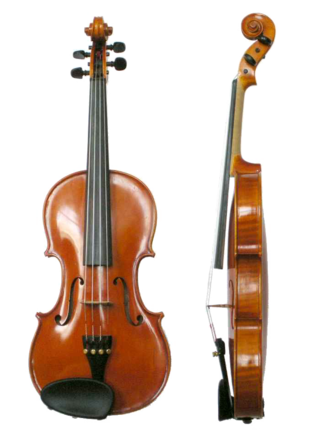
The violin, sometimes known as a fiddle, is a wooden chordophone in the violin family. Most violins have a hollow wooden body. It is the smallest and thus highest-pitched instrument (soprano) in the family in regular use. The violin typically has four strings, usually tuned in perfect fifths with notes G3, D4, A4, E5, and is most commonly played by drawing a bow across its strings. It can also be played by plucking the strings with the fingers (pizzicato) and, in specialized cases, by striking the strings with the wooden side of the bow.

String instruments, stringed instruments, or chordophones are musical instruments that produce sound from vibrating strings when a performer plays or sounds the strings in some manner.
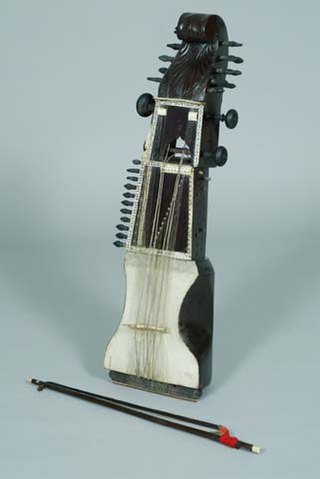
The sārangī is a bowed, short-necked three-stringed instrument played in traditional music from South Asia – Punjabi folk music, Rajasthani folk music, and Boro folk music – in Pakistan, India and Bangladesh. It is said to most resemble the sound of the human voice through its ability to imitate vocal ornaments such as gamaks (shakes) and meends. The Nepalese sarangi is similar but is a folk instrument, unornate and four-stringed.

The erhu is a Chinese two-stringed bowed musical instrument, more specifically a spike fiddle, which may also be called a Southern Fiddle, and is sometimes known in the Western world as the Chinese violin or a Chinese two-stringed fiddle.
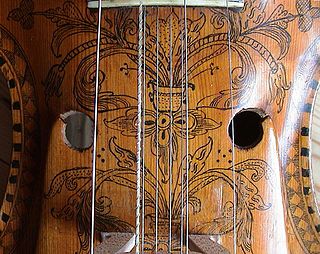
Sympathetic strings or resonance strings are auxiliary strings found on many Indian musical instruments, as well as some Western Baroque instruments and a variety of folk instruments. They are typically not played directly by the performer, only indirectly through the tones that are played on the main strings, based on the principle of sympathetic resonance. The resonance is most often heard when the fundamental frequency of the string is in unison or an octave lower or higher than the catalyst note, although it can occur for other intervals, such as a fifth, with less effect.

Music of Jammu and Kashmir reflects a rich musical heritage and cultural legacy of the Indian-administered union territory of Jammu and Kashmir. Two different regions of Jammu and Kashmir consists the Jammu region and Kashmir Valley. Music of Kashmir Valley has influences of Central Asian music while music from Jammu region is similar to that of other regions of North India.

Folk music of Haryana has two main forms: classical folk music of Haryana and desi folk music of Haryana. They take the form of ballads and pangs of parting of lovers, valor and bravery, harvest and happiness.

A folk instrument is a traditional musical instrument that has remained largely restricted to traditional folk music, and is not usually used in the classical music or other elite and formal musical genres of the culture concerned, though related intruments may be.
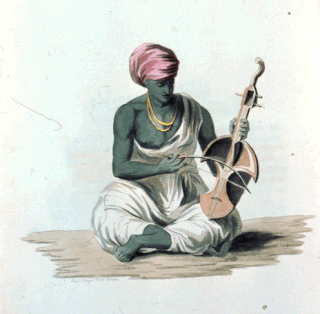
A sarinda or saranda is a stringed folk musical instrument from North and Eastern India and Pakistan, similar to the Sarangi, lutes, and the fiddle.

The bladder fiddle was a folk instrument used throughout Europe and in the Americas. The instrument was originally a simple large stringed fiddle made with a long stick, one or more thick gut strings, and a pig's-bladder resonator. It was bowed with either a notched stick or a horsehair bow.
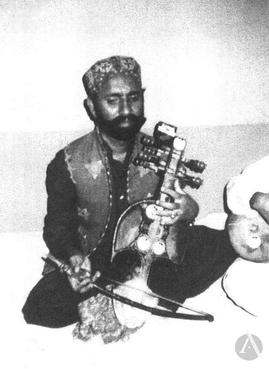
The suroz is a bowed string instrument with a long neck, similar to a fiddle or sarangi and played vertically. It is considered the traditional instrument of the Baloch people in Balochistan.

Ram Narayan, often referred to with the title Pandit, is an Indian musician who popularised the bowed instrument sarangi as a solo concert instrument in Hindustani classical music and became the first internationally successful sarangi player.

The Nepali Sarangi is a Nepali folk instrument. It is a chordophone played by bowing. Traditionally in Nepal, the Sarangi was only played by people of Gandarbha or Gaine caste, who sing narrative tales and folk song, however, in present days, its popularity extends beyond the Gandharba community and is widely used and played by other caste members as well. It has also garnered much interest in other music genres, such as Nepali rock and film music. While the Sarangi has become the quintessential Gandharba instrument, while its counterpart, the arbajo, which is a plucked lute, has fallen into obscurity.

The arbajo is a Nepali four-string lute used as a rhythm instrument. It is the traditional instrument of the Gandarbha caste of musical performers, and is considered a companion to the Nepali sarangi. The Gandarbhas consider the aarbajo to be the "male instrument", the sarangi the "female." The aarbajo is used less than in the past, and been replaced by the sarangi, which was considered in 1999 to have superseded the aarbajo in common use.
The dhantara is a bowed string instrument found in Himachal Pradesh state of India. The instrument is similar to the classical sarangi, but is more primitive, having only three melody strings and no tarab. The instrument is popular among the Gaddi people of that state, and often decorated with flowers.

The classicalkemenche, Armudî kemençe or Politiki lyra is a pear-shaped bowed instrument that derived from the medieval Greek Byzantine lyre.
Kingri is a chordophone Indian bowed string instrument, similar to Rabab and Ravanastron. It has a resonator box of unglazed pottery, through which a stick is passed to function as the neck.
The Musical instruments of Rajasthan include:















